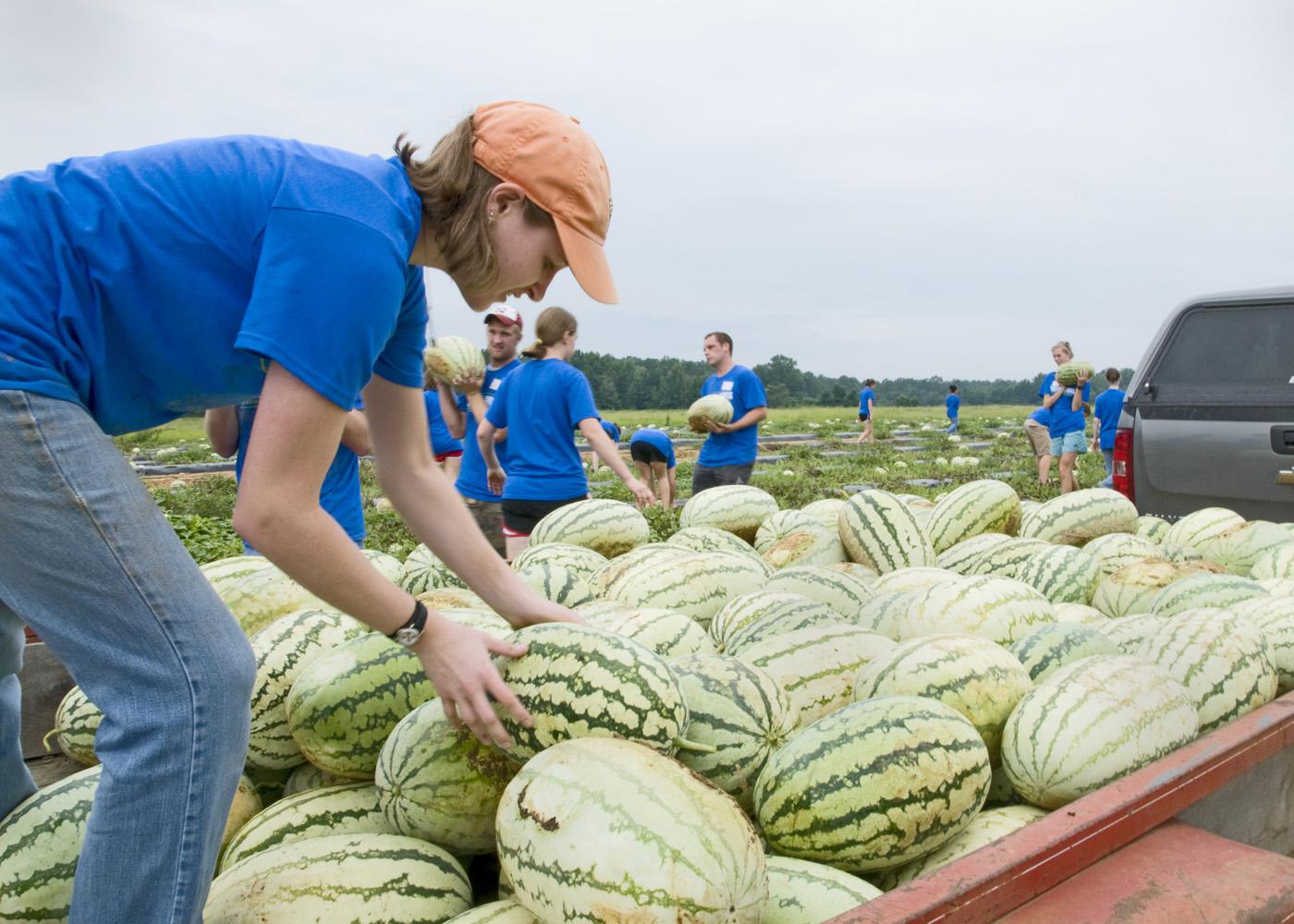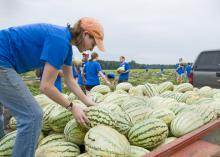Information Possibly Outdated
The information presented on this page was originally released on August 21, 2008. It may not be outdated, but please search our site for more current information. If you plan to quote or reference this information in a publication, please check with the Extension specialist or author before proceeding.
MSU DAWGS glean wisdom from service
By Patti Drapala
MSU Ag Communications
MISSISSIPPI STATE -- Mississippi State University took full responsibility for recently letting 35 “dawgs” out on the watermelon farm of two Webster County brothers.
Steve and Myron May, who grow produce under the name Farm Fresh, opened their post-harvest melon acreage to MSU's Service DAWGS. The Service DAWGS program is MSU's first-ever community service program for incoming freshmen.
The DAWGS pulled melons on behalf of the Society of St. Andrew, a national charity that seeks volunteers to pick up, or glean, produce left after harvest for distribution to food pantries and soup kitchens.
“When peak harvest time is over, farmers can't afford to pay labor to go back into the field for leftover produce,” Myron May said. “We were thrilled when the Service DAWGS called us.”
About 139 freshmen signed up for the Donating A Wonderful Gift of Service program. Faculty and staff also were eligible to volunteer, and 50 of them did. Each Service DAWG was assigned to a team that assisted a sponsoring agency with a community project.
“I was encouraged by the participation and enthusiasm of the students, faculty and staff,” said April Heiselt, MSU assistant professor of counseling and educational psychology. “We can only get bigger and better.”
Heiselt also is the service learning coordinator for MSU student leadership programs, such as Day One Leadership.
When assistant Extension professor Chiquita Briley of the Department of Food Science, Nutrition and Health Promotion heard about Service DAWGS, she decided the program would be a good opportunity for her department to combine forces with Day One as part of its participation in the national War on Hunger initiative.
“The Service DAWGS offered students a fresh way to understand how they could help fight hunger,” Briley said. “Many students have worked on food drives and volunteered for food pantries, but why not get them out in the field picking, pulling and lifting so healthy food can get to local food pantries.”
Students gleaned more than 1,700 melons, the equivalent of 42,500 pounds, in two hours. Most of the melons averaged 25 pounds. They had a farm-gate value of $8,500 and would have sold for $5 each at grocery stores, roadside stands and farmers markets.
Larry Woodward, program coordinator for the society's gleaning network in Mississippi, said the melons provided 125,000 servings of food.
“A large number of hands working together in a short amount of time achieved something important,” he said. “Those melons were delivered to food pantries within 24 hours of being gleaned, and people in need were able to enjoy a little bit of luxury they could not afford.”
Many of the students who joined the Service DAWGS said they enjoyed the sense of purpose they felt working together for the common good. Others said they had participated in community service projects in their hometowns and were motivated to continue while in college.
“I delivered for Meals on Wheels back home and was a Girl Scout,” said Robin Armstrong, a mathematics major from New Albany. “It's important to give back.”
Faculty and staff who volunteered to be site leaders, registration assistants and lunch servers said they felt a similar camaraderie.
“What impressed me the most about the experience is the number of students who signed up or who decided to walk up that day,” said MSU senior associate athletic director Ann Carr, who is responsible for women's sports and student-athlete services. “They were incoming freshmen who did not know one another and didn't have friends to ask ahead of time, but they came anyway.”
Heiselt said she would like to see the Service DAWGS established as a permanent student group conducting community service throughout the year.
“Students learn through serving others,” she said. “We want to help them further their education by making this connection.”




